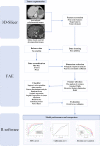The added value of radiomics from dual-energy spectral CT derived iodine-based material decomposition images in predicting histological grade of gastric cancer
- PMID: 36192686
- PMCID: PMC9528064
- DOI: 10.1186/s12880-022-00899-y
The added value of radiomics from dual-energy spectral CT derived iodine-based material decomposition images in predicting histological grade of gastric cancer
Abstract
Background: The histological differentiation grades of gastric cancer (GC) are closely related to treatment choices and prognostic evaluation. Radiomics from dual-energy spectral CT (DESCT) derived iodine-based material decomposition (IMD) images may have the potential to reflect histological grades.
Methods: A total of 103 patients with pathologically proven GC (low-grade in 40 patients and high-grade in 63 patients) who underwent preoperative DESCT were enrolled in our study. Radiomic features were extracted from conventional polychromatic (CP) images and IMD images, respectively. Three radiomic predictive models (model-CP, model-IMD, and model-CP-IMD) based on solely CP selected features, IMD selected features and CP coupled with IMD selected features were constructed. The clinicopathological data of the enrolled patients were analyzed. Then, we built a combined model (model-Combine) developed with CP-IMD and clinical features. The performance of these models was evaluated and compared.
Results: Model-CP-IMD achieved better AUC results than both model-CP and model-IMD in both cohorts. Model-Combine, which combined CP-IMD radiomic features, pT stage, and pN stage, yielded the highest AUC values of 0.910 and 0.912 in the training and testing cohorts, respectively. Model-CP-IMD and model-Combine outperformed model-CP according to decision curve analysis.
Conclusion: DESCT-based radiomics models showed reliable diagnostic performance in predicting GC histologic differentiation grade. The radiomic features extracted from IMD images showed great promise in terms of enhancing diagnostic performance.
Keywords: Dual-energy spectral CT; Gastric cancer; Histologic grade; Iodine-based material decomposition images; Radiomics.
© 2022. The Author(s).
Conflict of interest statement
The authors declare that they have no competing interests.
Figures








Similar articles
-
Radiomics Analysis to Predict Lymphovascular Invasion of Gastric Cancer Based on Iodine-Based Material Decomposition Images and Virtual Monoenergetic Images.J Comput Assist Tomogr. 2024 Mar-Apr 01;48(2):175-183. doi: 10.1097/RCT.0000000000001563. Epub 2023 Nov 24. J Comput Assist Tomogr. 2024. PMID: 38110306
-
Assessing muscle invasion in bladder cancer via virtual biopsy: a study on quantitative parameters and classical radiomics features from dual-energy CT imaging.BMC Med Imaging. 2024 Sep 16;24(1):245. doi: 10.1186/s12880-024-01427-w. BMC Med Imaging. 2024. PMID: 39285354 Free PMC article.
-
Radiomics analysis of dual-energy CT-derived iodine maps for diagnosing metastatic cervical lymph nodes in patients with papillary thyroid cancer.Eur Radiol. 2020 Nov;30(11):6251-6262. doi: 10.1007/s00330-020-06866-x. Epub 2020 Jun 4. Eur Radiol. 2020. PMID: 32500193
-
Intratumoral and peritumoral radiomics analysis for preoperative Lauren classification in gastric cancer.Cancer Imaging. 2020 Nov 23;20(1):83. doi: 10.1186/s40644-020-00358-3. Cancer Imaging. 2020. PMID: 33228815 Free PMC article. Clinical Trial.
-
Radiomics in precision medicine for gastric cancer: opportunities and challenges.Eur Radiol. 2022 Sep;32(9):5852-5868. doi: 10.1007/s00330-022-08704-8. Epub 2022 Mar 22. Eur Radiol. 2022. PMID: 35316364 Review.
Cited by
-
Intra- and Peritumoral CT-Based Radiomics for Assessing Pathologic T-Staging in Clear Cell Renal Cell Carcinoma: A Multicenter Study.Ann Surg Oncol. 2025 Jun;32(6):4550-4561. doi: 10.1245/s10434-025-17111-4. Epub 2025 Mar 19. Ann Surg Oncol. 2025. PMID: 40106107
-
What to Expect (and What Not) from Dual-Energy CT Imaging Now and in the Future?J Imaging. 2024 Jun 26;10(7):154. doi: 10.3390/jimaging10070154. J Imaging. 2024. PMID: 39057725 Free PMC article. Review.
-
Radiomics analysis of dual-layer spectral-detector CT-derived iodine maps for predicting tumor deposits in colorectal cancer.Eur Radiol. 2025 Jan;35(1):105-116. doi: 10.1007/s00330-024-10918-x. Epub 2024 Jul 11. Eur Radiol. 2025. PMID: 38987399
-
A nomogram model of spectral CT quantitative parameters and clinical characteristics predicting lymphovascular invasion of gastric cancer.Heliyon. 2024 Apr 3;10(7):e29214. doi: 10.1016/j.heliyon.2024.e29214. eCollection 2024 Apr 15. Heliyon. 2024. PMID: 38601586 Free PMC article.
-
Zinc Finger Proteins in the War on Gastric Cancer: Molecular Mechanism and Clinical Potential.Cells. 2023 May 4;12(9):1314. doi: 10.3390/cells12091314. Cells. 2023. PMID: 37174714 Free PMC article. Review.
References
MeSH terms
Substances
LinkOut - more resources
Full Text Sources
Medical
Miscellaneous

